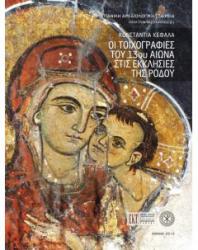Title:
Thirteenth Century wall paintings in the churches of Rhodes
Abstract:
The study focuses on the monumental painting of the island of Rhodes, Greece, during the 13th century and specifically from the year 1204, when the Byzantine official Leo Gabalas took over the administration of the island, until the arrival of the
Knights of Saint John in 1309. The remains of the artistic production are located in six churches in the town and the countryside of Rhodes. The monuments in question are presented in chronological order. After the detailed description and
iconographic examination follows the stylistic analysis of the murals along with the proposed dating. In particular, the study deals with the frescoes of Saint Phanourios in the Medieval Town of Rhodes, of the monastery of the Archangel Michael at
Thari, of Saint John the Theologian at “Koufas” in Paradeissi, of + Saint Nicetas in Damatria, of Saint George Vardas in Apolakkia and of Saint George in Asklepeio. Two sections in the unit on the church of Saint George Vardas were
expanded because of their special interest: one concerns the epithet Panagia Akedioktene which accompanies the representation of the Virgin Glykophilousa and the other deals with the iconography and local cult of Saint Philemon, given his
representation in the church. Given that the paintings of the church of Saint George Kounaras at Asklepeio is ascribed to the same hand as that of Saint George Vardas, the painter’s style in both monuments and the particularities of his art are
The study focuses on the monumental painting of the island of Rhodes, Greece, during the 13th century and specifically from the year 1204, when the Byzantine official Leo Gabalas took over the administration of the island, until the arrival of the Knights of Saint John in 1309. The remains of the artistic production are located in six churches in the town and the countryside of Rhodes. The monuments in question are presented in chronological order. After the detailed description and iconographic examination follows the stylistic analysis of the murals along with the proposed dating. In particular, the study deals with the frescoes of Saint Phanourios in the Medieval Town of Rhodes, of the monastery of the Archangel Michael at Thari, of Saint John the Theologian at “Koufas” in Paradeissi, of + Saint Nicetas in Damatria, of Saint George Vardas in Apolakkia and of Saint George in Asklepeio. Two sections in the unit on the church of Saint George Vardas were expanded because of their special interest: one concerns the epithet Panagia Akedioktene which accompanies the representation of the Virgin Glykophilousa and the other deals with the iconography and local cult of Saint Philemon, given his representation in the church. Given that the paintings of the church of Saint George Kounaras at Asklepeio is ascribed to the same hand as that of Saint George Vardas, the painter’s style in both monuments and the particularities of his art are examined in a special chapter. In the final part of the book is developed the overall consideration of the artistic production: the structure and order of the iconographic programmes are assessed, some interesting issues of iconography are discussed, as well as matters concerning the donors of the churches. The stylistic trends are analysed, compared with monuments from other Dodecanese islands and within the artistic currents of the first and second half of the 13th century.









